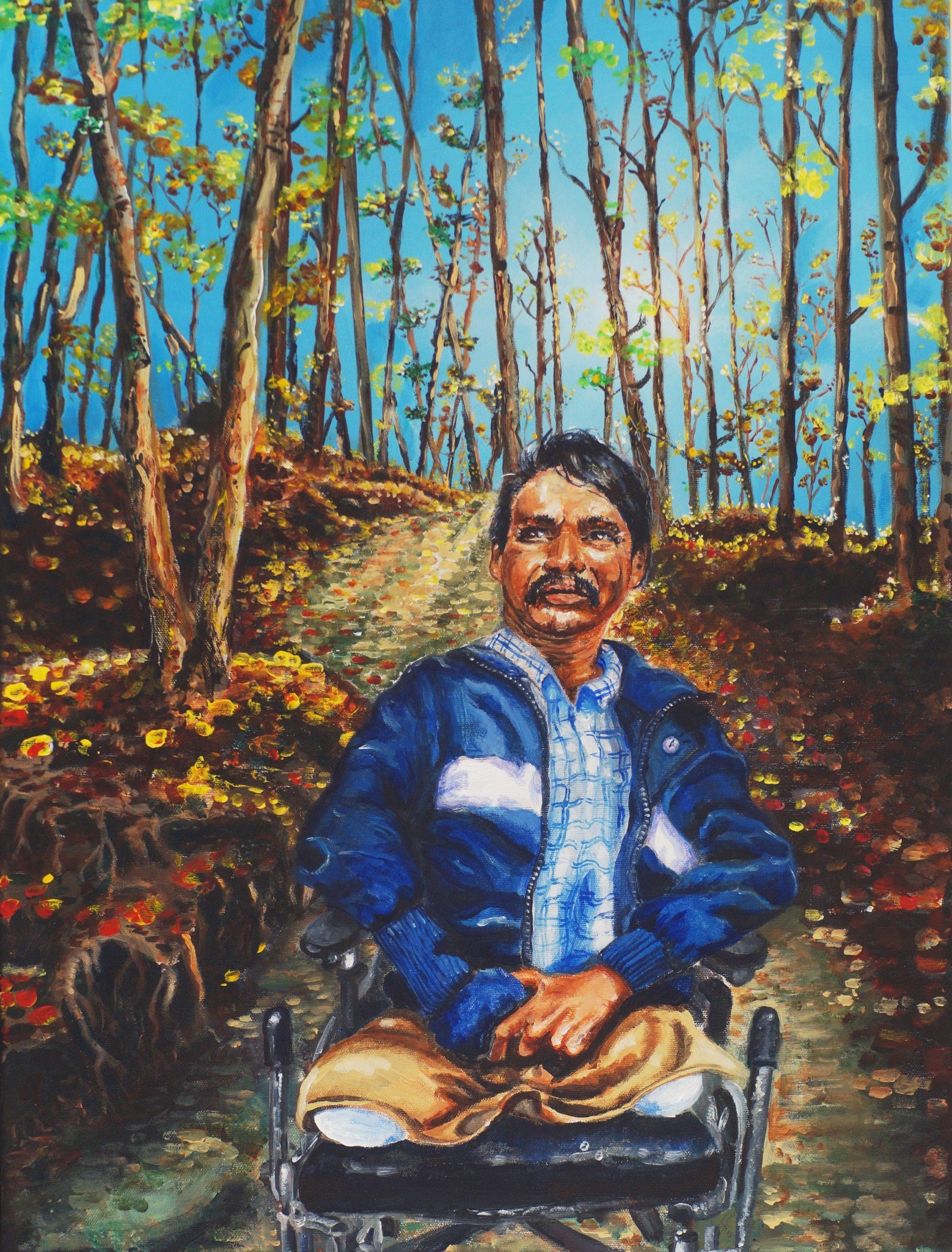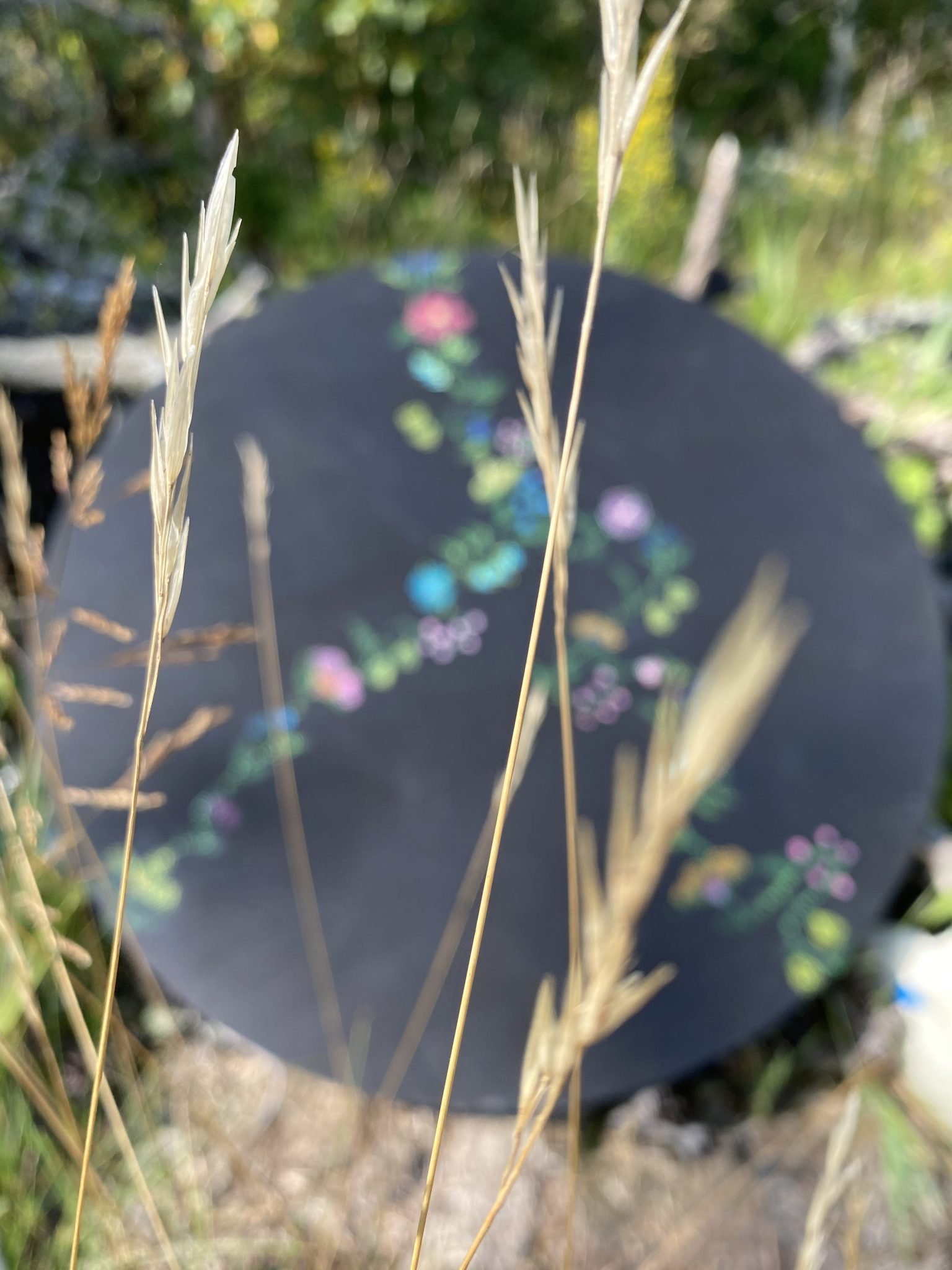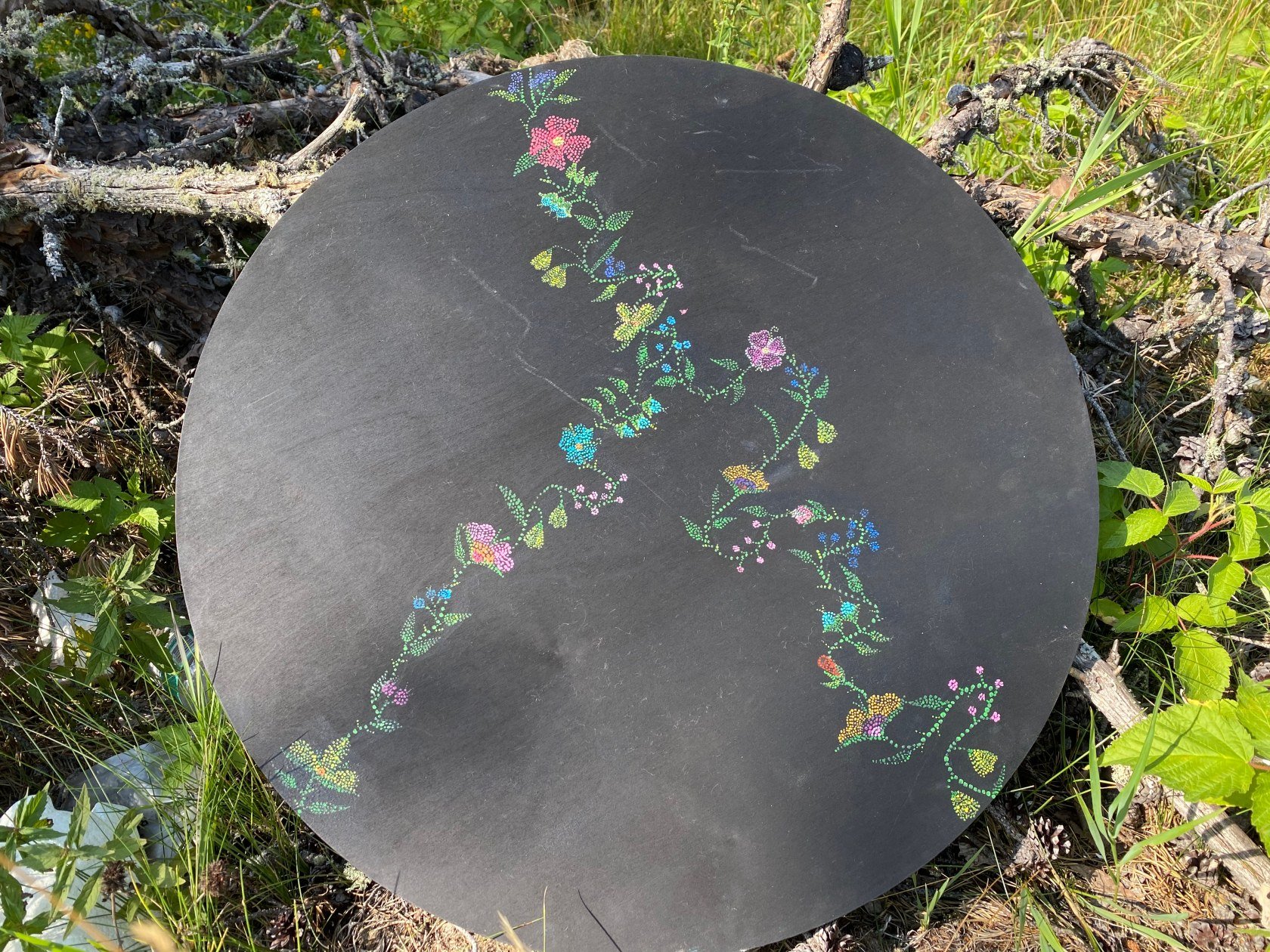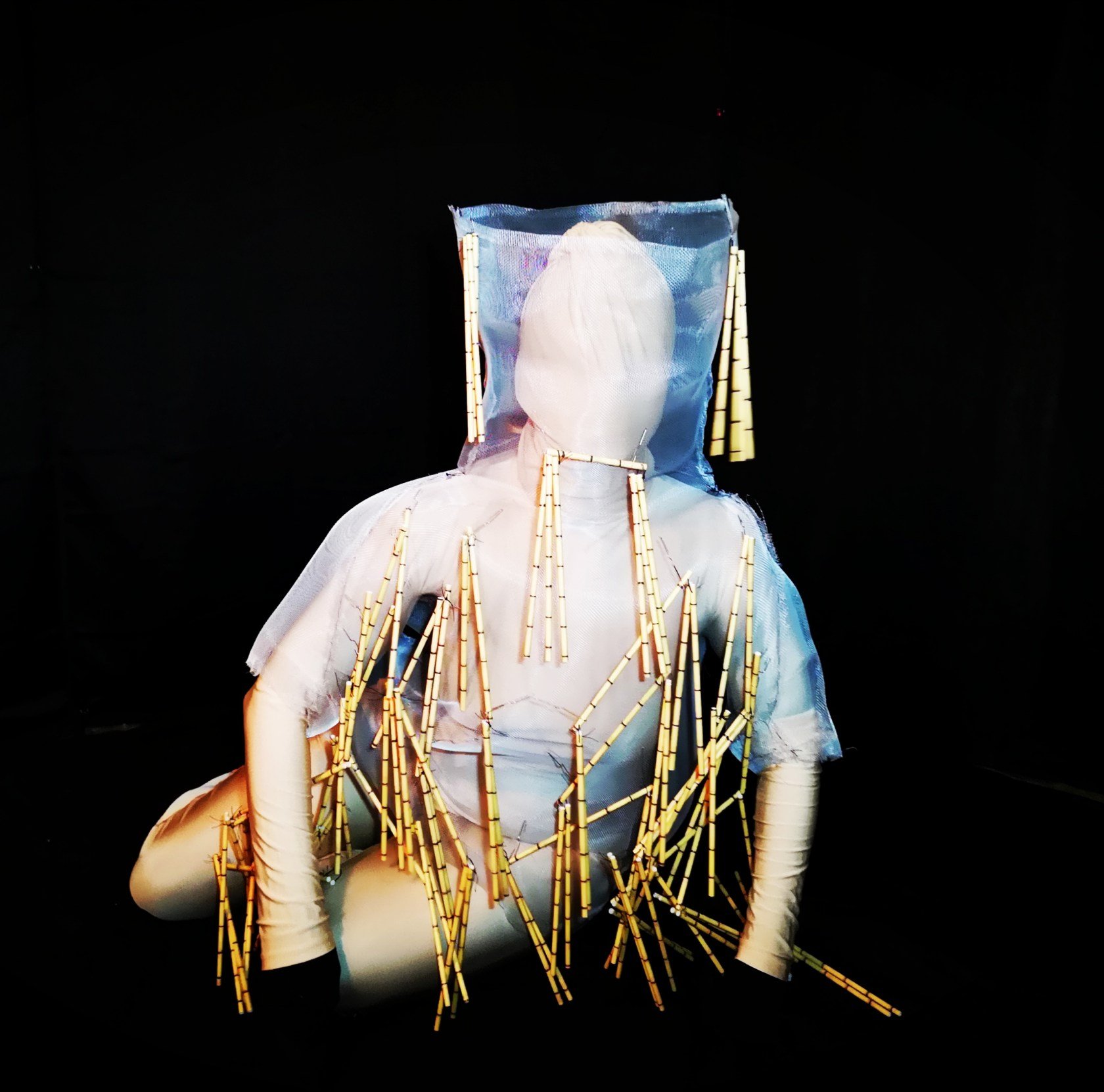CARE MICROGRANTS: ROUND 2
Following the success of the first round of the CARE Microgrant project, we joined hands again with QPOC (Queer and Trans People of Colour–Winnipeg) and made a new connection with MAWA (Mentoring Artists for Women’s Art) to curate a second round.
In continuum with the motivations behind the first call, the second round of the CARE Microgrant project also provided swift financial support ($300.00) for small creative project proposals influenced by the humanities. We welcomed proposals from students and community members that explored the multiple dimensions of care, caring, and being careful. These included the (gendered and raced) labour of healthcare, the physical and/or emotional aspects of care, caring for or about a certain cause, or what it means to be careful in this moment of social distancing, for example. Projects that centred queer, critical race, and Indigenous approaches to care were prioritized. Jury members consisted of representatives from QPOC, MAWA, and the UMIH (staff, board members, and student interns).
As with the first round, we hope these heartfelt, small gestures of care meet you well. Please refer to Round 1 for more context on the beginnings and motivations behind this project.
Award Recipient Submissions:
Niamh Dooley –
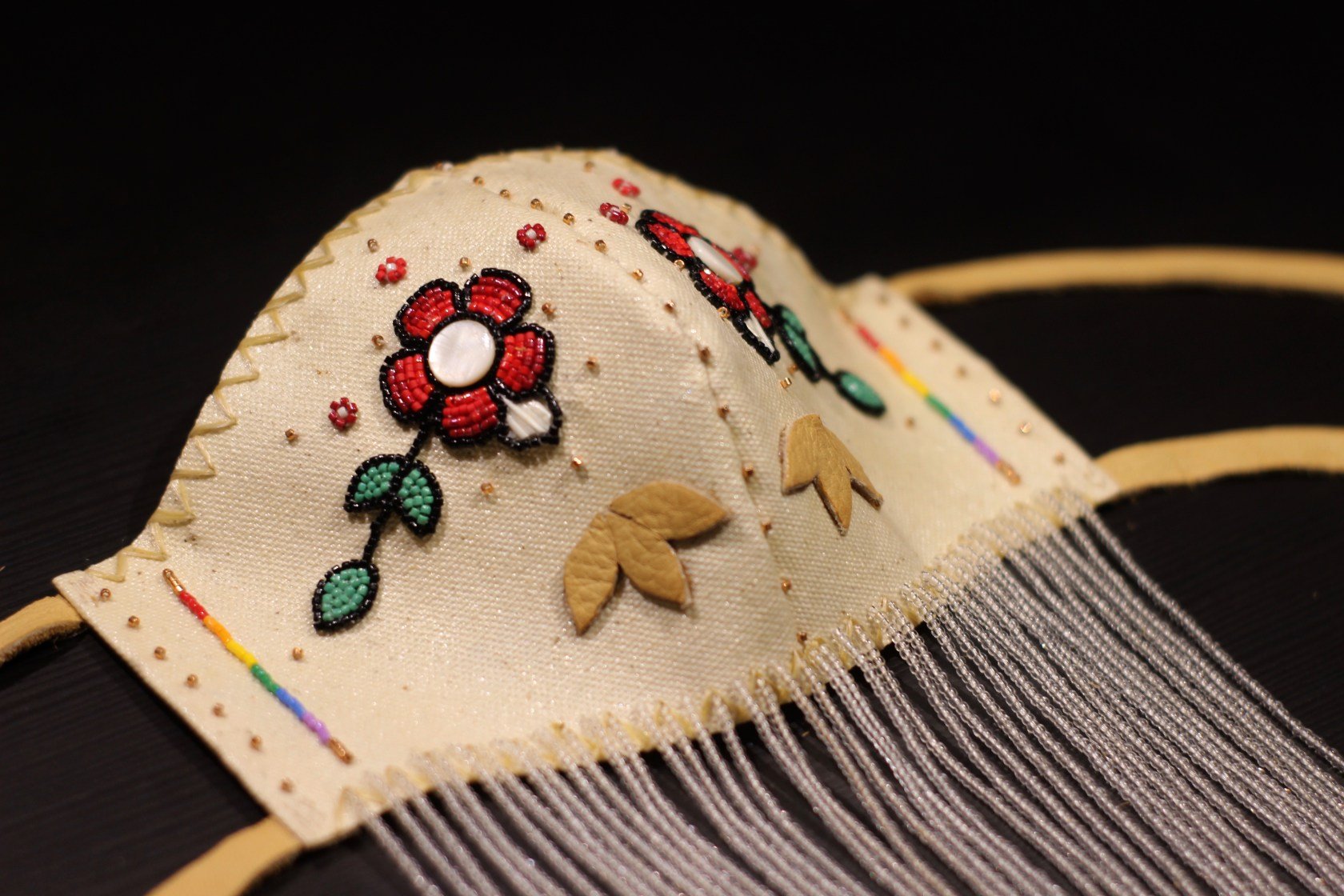
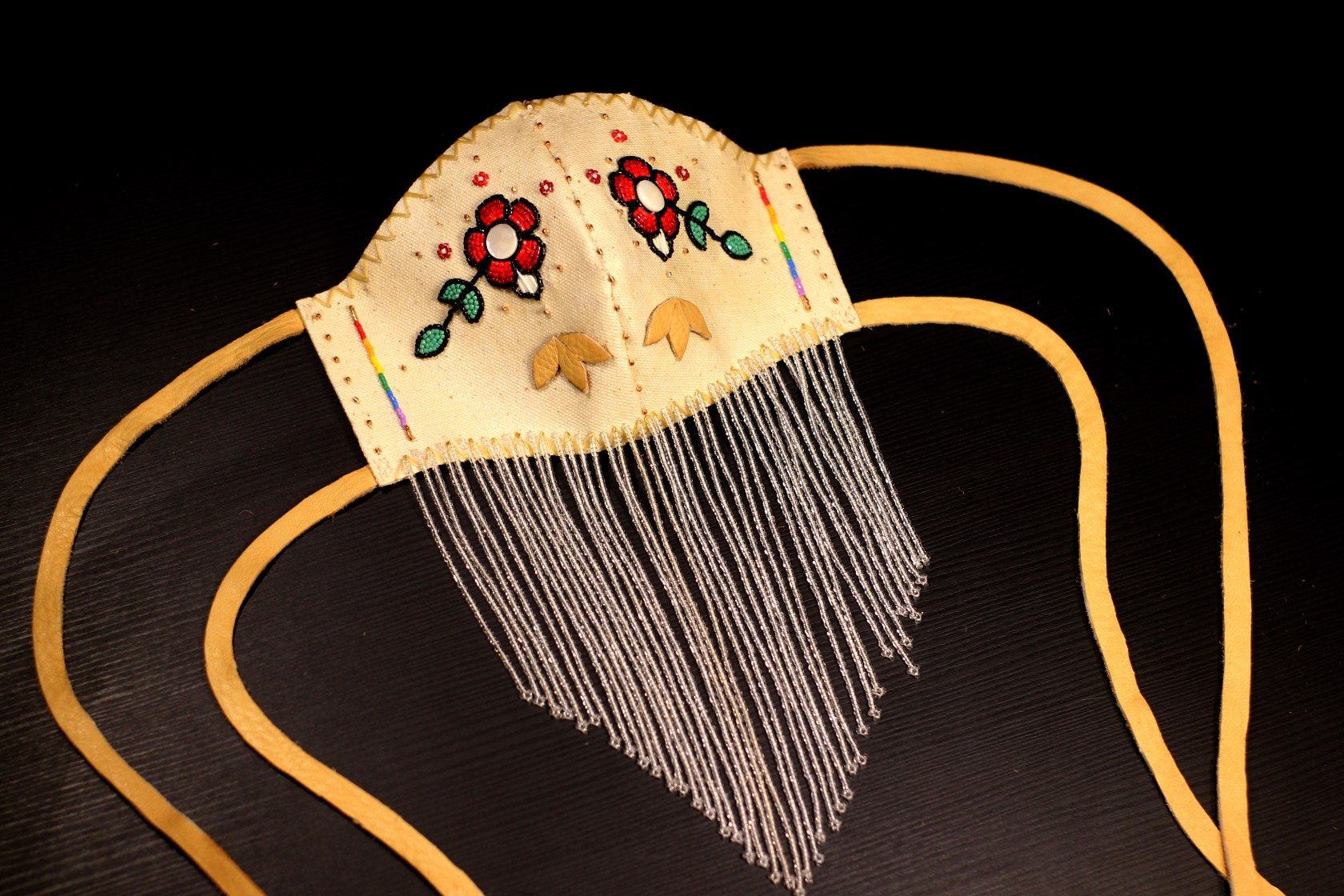
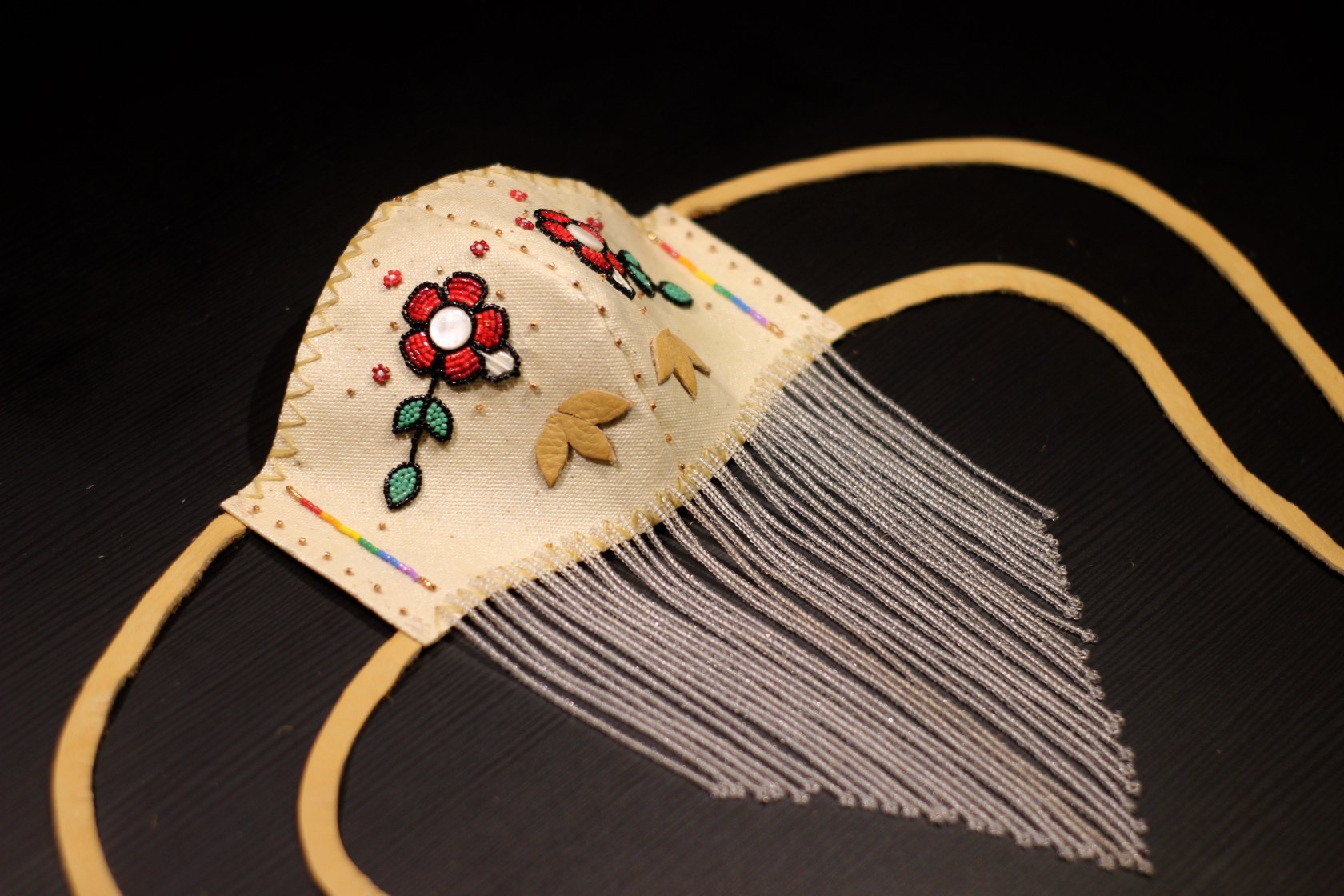
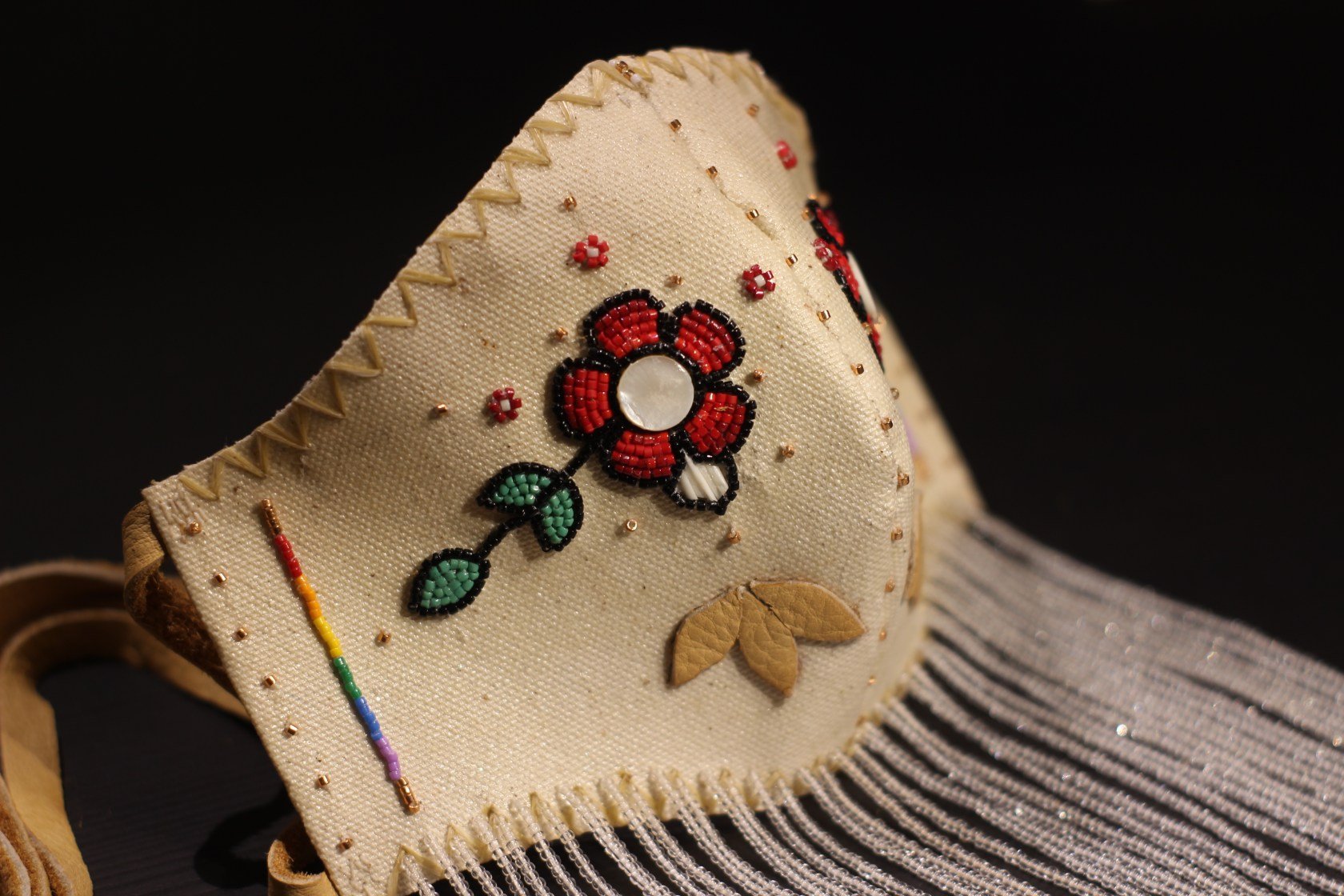
Niamh Dooley
During these trying times I have found more time to bead and make more art, not only creating pieces I am passionate about but for my overall well-being. Beading to me is often a therapeutic activity, a way of connecting to my maternal relatives and ancestors. Since my Kookim passed away before I started beading, it’s a way of connecting to her, looking at her designs for inspiration along with all my other relatives who bead, especially floral designs seen in their work.
This mask is created on canvas prepped with rabbit skin glue using floral beadwork with size 11 Delica beads, shell button centres and a quill leaf, one on each cheek with leaves stemming from them outward. Incorporating other elements into the mask such as elk hide leaves, elk hide straps, and sinew edging the mask to accompany the beadwork. Along the bottom of the mask is a fringe of seed beads, using over 3000 beads to dangle. On each end of the mask is a rainbow detail with Delica beads as a representation of myself incorporated into the mask as an Indigiqueer, alongside the inspirations of my maternal family.
Chukwudubem Ukaigwe –
Film stills – How High is the Moon, a film by Chukwudubem Ukaigwe. 2020. showing via Winnipeg Film Group.
How High is the Moon analyzes Black civil rights in the ghost of ontology. Filmmaker, Chukwudubem Ukaigwe takes an anthropological approach in mapping Pan-African Black resistance, drawing and analyzing parallels between history and present realities, and also speculating future relationships between race, class, and ideological groupings. Music is the bedrock and spine of this film; shaping the narrative, and creating push and pulls, therefore building a progression of tension throughout the film. The film is composed of manipulated videos from archival sources, which are tailored gently with scripted roles/ filmed scenes that were written and directed by the artist.
This film leans heavily on a literary Catharsis. Parts of the Monologues and dialogues from this film (written by Chukwudubem Ukaigwe), were chopped up, reconstructed, and stitched into a poem, which was published by the Winnipeg Art Gallery with the title; ‘This Cup’. The film treats poetics as an art form that supersedes an expression of abstract emotions. It reveals the reality of living within the atmosphere of a poem.
Please see full video screen through the link below:
https://www.winnipegfilmgroup.com/event/how-high-is-the-moon/#video
Ashley Au –
Golden Hour is a piece of music that brings to light the challenges in providing support and care to loved ones from a distance—especially those who struggle with anxiety and depression, which has been exacerbated by the global pandemic and the resulting periods of isolation that comes hand in hand with protecting community health.
Lyrically, the song shifts perspectives between the supporter and the loved one seeking support,
pairing a moment of crisis with a serene instrumental arrangement—a reflection of the delicate balance one must find when supporting someone through a mental health crisis from afar.
Soundcloud link courtesy of the artist. Golden Hour, 2020 written and composed by Ashley Au:
Clea August –
Clea August, Bipolar, 2020. Images courtesy of the artist. Diameter 50cm, depth 3cm, weight .56k
Bipolar is a very tricky thing. No one knows why it happens or why meds work, or don’t work.
Bipolar is a storyteller, a trickster; weaving truths and lies so seamlessly until all you see is the beautiful tapestry and none of the blood and bone from which it’s made. All the pain and screaming and fear, so nicely tied up, stitch by stitch. Bipolar is a master weaver, hiding each loose thread, each missed stitch with careful attention. On one pole, you feel thick and slow, every movement, every moment is weighted and dull and too big to fight. Bipolar tells you ‘Hang on! Hang on! This is the price!’ And you know, deep down, you know it’s right, because the other side, oh the other side is bright! Your rightful place as a god awaits there.
And Bipolar weaves the story of your ‘God hood’; word by word, sentence by sentence it winds the tale of things to come, if you have the strength to endure.
No sleep, no food, no sadness, no hate. A perfect being awaits you, full of joy and thought. A new bright God to be worshipped by all, and they will worship oh yes. They will offer up gifts and sacrifices, if you can just hang on. If you can weave a story long enough to get to the other side and you hang on and you wait, and you hide every faulty thread, to be born again and again and again. You will hear every lie and every horrible truth and live as you were. In the light and joy of unending happiness, you are watching your old life burn away. That small and sad mortal thing becomes ash as you become what you should always be. “Yes, Yes!”, Bipolar says, “Remember who you really are! You are a goddess and the earth shudders when you wake!”.
Until then you sleep, you function, you go through the motions of humanity, always waiting, always.
Kay –
tansi,
as my life began to slow down, I found solace in the energy that has always lived inside of me: to me being two spirit is one of my greatest gifts – I care for the fire inside of me, the way I do the water. my greatest contribution to this life, will be the life I make when the time comes.
Self-care is community care: take this time to heal yourself, to love yourself so you can also love the communities we are building.
In many ways my life has changed the way I think, the way I feel: everything I do now, I do for the purpose of care, whether that be care for myself, care for the community, or care for my future.
with love, kay
Wednesday, June 17th, 2:03am
vulnerability is an act of ceremony
reclamation
and resistance
+
writing comes with a certain amount of self-disclosure
these words tell you
the story of abuse
but also, the story of healing
+
to a certain extent I believe
I live my most vulnerable life-
sharing pieces of myself
everywhere I go
things I wish to not be returned
+
I cannot begin to tell you
the nights I’ve fallen into lust
only to wake up unsatisfied
and unseen
+
vulnerability is an act of ceremony
intimacy is sacred
+
wanting you in a way that serves the deepest parts of my soul
making me feel secure, the way picking medicine for my community does:
when I allow myself to fall fully, into me
it will be my most revolutionary ceremony,
true vulnerability, allowing myself to be known fully, and seen truly
my most radical act of resistance: will be the love I have for myself
it’s written in the sun, and the stars.
Friday, July 3, 10:14pm
walking in two worlds: my physical body here
my spirit somewhere, holding your hand.
losing you, but having you so close to my heart.
small moments, of frustration and anger
I wish you could just be here
why must I suffer to feel you
my night spent under the stars was the closest thing
to being in your arms I have felt in years,
I no longer imagine sitting on your shoulders
because you came to see me in my dream:
rubbed my back
kissed my forehead
our time together is never long, but it leaves me feeling full.
I worry that I sound crazy, talking about you
talking to you; screaming at you
how could you leave me
why don’t you visit me more
how can I get you to hold my hand
your journey to the spirit world was years ago;
that is your home now.
how lucky am I to have you come back to earth
when I am doing the most sacred things,
to rub my back when I am fasting;
to hold my hand while I am in prayer.
I would love more of you;
and when that day comes,
we will have had years of times together,
and years of time to make up for.
Saturday, August 2, 11:23am
my dearest; please know
I pray for your happiness
as I pray for my own-
the way I pray for the land we will live on together:
I often think about praying you down from the stars
and the joyous feelings I will have when I feel you in my arms;
when my body becomes your home I will know
everything I have done up until now, to heal is for you.
Recently, I have found solace in the idea that
as of now, your spirit lives in a scared place
that as I do my work, to heal
you are dancing with our ancestors
and learning the ways they love you:
when we are both ready for you to come down from the sky
you will have the hearts of
aunties you haven’t met;
and a grandma who breathes love, and strength
my dearest Nellie; you are so loved.
Tuesday, August 11, 3:14pm
it has been my connection to ceremony
that has taught me love
for the women in my life;
these connections are ones I hold dearest to my heart
sweet as berries and as fierce as fire
they have taught me many lessons
this kind of a connection makes my heart sing
being loved in a way that makes you feel so vulnerable
but so safe.
A love that’s more than a love.
These women in my life celebrate my success no matter how big or small it may seem,
praise my beauty in however it may look like
their voices empower mine – together in harmony.
we succeed as one.
when things get hard they offer a shoulder to cry on;
tell me the hard truths
and remind me of all the beauty in the world
I pray for you,
I love you.
you are my whole world
Stephanie Phillips –
Stephanie Phillips, A portrait of Brian Sinclair. Close-up work in progress photos courtesy of the artist.
I am a person of color who is often mistaken for Indigenous in Winnipeg, where I’ve lived most of my life. I have also struggled with an addiction. I never realized how racist Winnipeg is until I sought help for my addiction at the age of 24. Prior to this, my family, friends and people who met me on my path generally treated me with respect. When I decided to seek help, I was subjected to questions such as “How do you get money, if you’re not on welfare?” and, upon learning I was employed by a university professor, “Are you her nanny or are you her maid?” I was her research assistant. The racism was beyond anything I had encountered, and it was perpetrated by workers in health and social services.
Four years later, Brian Sinclair died from a treatable infection after spending 34 hours in the waiting room of the Health Sciences Centre without being seen by a doctor. Because of his race, hospital staff assumed he was drunk and “sleeping it off”, ignoring his clear need for medical care. I was furious and sad, but not surprised. Brian Sinclair died due to racism in the health care system, something I was and am familiar with. I read about his life online and was touched by his story. I read he once ran into a burning building to save the inhabitants; that his family said he carried himself with determination and dignity, despite his challenges; that he was “humble, but not a pushover”, in the words of a pastor who worked with him. I hoped to capture his spirit at peace in his portrait, to honor a man who both thought of others and respected himself.
I’d like to think that things have changed since Brian Sinclair’s death, but recent headlines show systemic racism is alive and well in Canada. I feel that until people’s attitudes change, tragedies will continue. Brian Sinclair’s cousin, Robert Sinclair, said: “It’s terrible to remember that he actually died that way. I’d like to think that he passed away teaching us all something, teaching us that as human beings, we have become so insensitive to each other.”
Here is a link to an interview with Robert Sinclair, talking about racism in the health care system:
https://www.cbc.ca/news/canada/manitoba/emergency-room-wait-brian-sinclair-racism-1.4832755
For those wanting to learn more about Brian Sinclair, here are some links:
http://ignoredtodeathmanitoba.ca/
https://en.wikipedia.org/wiki/Death_of_Brian_Sinclair
https://www.cbc.ca/news/canada/manitoba/winnipeg-brian-sinclair-report-1.4295996
Here is a link to an article about Joyce Echaquan, an Indigenous woman who died this October in a hospital in Quebec while being degraded by staff. The article also discusses racism in the health care system
https://time.com/5898422/joyce-echaquan-indigenous-protests-canada/
Purple Haze –
Purple Haze, 2020 drag performance. Courtesy of the artist.
From the Horrors of Lady Frances; Purple Haze is a Latinx Drag Artist who started with the Sunshine Bunch four and a half years ago. Also, a co-owner of Winnipeg based Drag Nail business Accènt’aigü Nailz. She is the current reigning Miss Like That 2020! and her high energy performances always leave you wanting more!
Drag is performative with gender expression and it infuses art, dance, musicality. It blurs the line between heteronormative ideologies and it’s a hell of a good time. This piece will explore the intersectionality of gender, drag performance and Latinx cultural identity with the help of music, choreography, and videography.
Nadya Crossman-Serb –
Nadya Crossman-Serb, 2020. Acrylic on wood panelling. Images and work courtesy of the artist.
This painting is a representation of Métis beadwork, and the traditional waterways Métis people use to trade and live. The Red River and Assiniboine River flow with medicine plants on a black background to represent brocade bags, vests, and other Métis items of clothing.
Carla E. Hernandez –
Written, narrated and edited by Carla E. Hernandez. Music: Paradise Jaywood. Camera Assistant: Wendy Hernandez.
Queer Fear is a short film that will take you through Carla’s 28 year journey of struggling to accept her sexual identity. After combating deep suicidal thoughts, Carla realized her mental health had been suffering for far too long and it was time to make a change. An emotional breakdown followed by a global pandemic, forced her to sit in isolation with her thoughts after years of suppressing them. Realizing now more than ever how important self care is, Carla begins a search for the answers she has been avoiding all these years. The journey to conquer queer fear for Carla wasn’t easy, but she proves that it’s not impossible.
Wendy Lee –
Wendy Lee. 2020. Image and work courtesy of the artist.
During the Covid pandemic, we are all interconnected by strands of love and life. The rainbow mask encompasses everyone, gender, race, LGBTQ community in safety. The heart is dedicated to the diligent healthcare workers that stand on the Frontlines with their gloved hands to protect and care for others. In this new reality, we are troubled with uncertainty, but our friends, neighbours and communities have come together in kindness and compassion when it really counts.
Thiané Diop –
Thiané Diop, 2020, Mr. Whistle Blow-Me.
Video Link: https://www.youtube.com/watch?v=EsQ1LTPmkGM&t=164s
Mister
By Mr. Whistle Blow-Me
With a special thank you to Dione C. Haynes for all your help and support.
These last few months have been full of everything for me: the good, the bad, the difficult, the complicated and the joyous. One of the more public ways in which this has manifested was through my creation of the hashtag #cmhrstoplying. This Instagram and Facebook-based hashtag is meant to hold the Canadian Museum for Human Rights (CMHR) accountable for its anti-black racism and other forms of racism that it participates in, perpetuates and upholds. The words “stop lying” were chosen to address the CMHR’s attempt to pretend that these public calls were a surprise to them instead of long-standing concerns that some of my former colleagues and I had brought up within the institution for years and which ultimately lead to each of us leaving.
I have taken this experience and crafted a drag number through my alter ego, Mr. Whistle Blow-Me, I specifically chose to use drag performance as a medium because of its long history of subversiveness and social commentary. My drag name acknowledges my experience as a whistle-blower while also highlighting my irreverence through humour. This piece has allowed me to reflect on my experiences at the CMHR and channel the complex web of emotions that has come with my decision to speak out publicly and hold a national institution accountable. I move from my initial excitement to experiences of being racialized, tokenized, and not fitting into institutions that I have been taught all my life to aspire to be a part of.
The title of my piece, Mister, is directly drawn from Toni Morrison’s novel, Beloved. Mister is a rooster who lived at the Sweethome plantation with many of the novel’s main characters. When thinking back to the plantation, one of the Sweethome men, Paul D, describes the rooster. He says “Mister, he looked so…free.” Paul D goes on to say “Mister was allowed to be and stay what he was. But I wasn’t allowed to be and stay who I was. Even if you cooked him you’d be cooking a rooster named Mister. But wasn’t no way I’d ever be Paul D again, living or dead.” (Morrison 86). What I want to capture in this performance is how existing institutions that were not built for me or others like me, that actively are working against us and our humanity, requires us to make ourselves smaller and give up pieces of ourselves. I chose to walk away, but I am still trying to figure out what those experiences mean for me. I’m still picking up the pieces after everything. I’m not sure if I still have all the pieces of myself that matter to me.
Chanelle Lajoie –
Chanelle Lajoie. 2020.
Chanelle Lajoie. 2020.
Chanelle Lajoie (She/Her) living on Treaty 1 Territory, the traditional territory of the Anishinaabeg, Cree, Oji-Cree, Ojibwe, Dakota, and Dene Peoples, and the homeland of the Métis Nation.
The best way I can offer care is through the making and sharing of comestibles. As an Indigi-queer person living independently, and further isolated from community and culture by Covid-19, I would like to document the consumption of a traditional meal as a practice of becoming both filled and fuelled through food as care.
Tanja Faylene Woloshen –
Tanja Faylene Woloshen
materials: aluminium screen, thread, bamboo straws, paperclips, spandex
photographer: J. Ostrowski
dancer: anonymous
As a dance artist, I have been self-teaching myself sculptural design. My work for the Make Anything Care Microgrant is research-creation for a wearable art/ costume piece with respect to a future (posthuman) nervous system. For this project, I am contemplating the interconnectivity of care.
This costume project will be part of a developing dance production exploring ecology and ecosomatics. Inspiration comes from Valla Walla; she describes: “(e)cosomatics is an emerging interdisciplinary field which connects movement education, improvisation, healing arts, psychology, ritual, performing arts, and good old-fashioned play with ecological consciousness. The practice of ecosomatics heals the separation between mind, body, and Earth by encouraging direct sensory perception of one’s body both in the natural environment and as the natural environment.”
This folds into my queer dance practice of multiple ways of being together.
Gratitude to UMIH & MAWA.
~ Tanja Faylene Woloshen
Omid Moterassed –
Omid Moterassed. 2020.
Nichol Marsch –
How to make a pumpkin pie with Nichol Marsch.
For a long time, I have been passionate about the idea of food and recipe sharing among friends and family, and the importance of self-sufficiency in preparing food. For this project I was motivated by the concepts: Cooking and baking are an activity that historically brings people together: Food can activate our memories: and the act of cooking can be therapeutic.
I hope you find this recipe valuable, and useful in your cooking journey. I encourage you to bake for yourself, swap baking with friends and family, drop a pie at a family member’s house, or find somewhere that takes food donations.
This project was made possible by the Make Anything CARE Microgrant, presented by the Institute for Humanities at the University of Manitoba, and QPOC Winnipeg, with support from MAWA.
How to Bake a Pumpkin Pie, with Nichol Marsch
Recipe and Video Tutorial (25min)
Nichols Pumpkin Pie Filling – (enough for 2 pies)
3 Cups Pumpkin Puree, 1 Can condensed milk (dairy-free substitute: Condensed coconut milk), 2 eggs (omit for vegan pie)
3/4 to 1 cup Brown sugar, 1-1/2 tablespoon cinnamon, 1 teaspoon ginger, 1 teaspoon nutmeg and a pinch of salt.
Directions:
1. Preheat oven to 400oF / 204oC
2. Combine pumpkin puree, condensed milk, eggs and sugar in a bowl and stir until combined
3. Add your spices! add some extra if you like a bit more spice.
4. Fill your pie shells(pre-made shells or make your own).
You can also use tart shells, mini pie shells, or bake the filling on its own for a nice pumpkin pudding!
5. Place the pie in the oven, cook for approximately 40 min, watch the colour of your crust should be golden brown.
Vegan Crust
2 Cups all-purpose flour, 3/4 teaspoon salt. 3/4 cup cold vegetable shortening, and 4-8 tablespoons cold water.
Non-Vegan Crust
5 1/2 cup all-purpose flour, 2 tsp salt, 1 pound lard or (1/2 butter, 1/2 lard), 1 tablespoon vinegar
1 egg – lightly beaten and Ice water.
Bonus Recipe: Pumpkin Muffins
½ cup butter , 1 ⅓ cup sugar, 2 eggs beaten, 1 tablespoon baking powder, ½ teaspoon baking soda
½ teaspoon Salt, ½ teaspoon ginger, ½ teaspoon nutmeg, 1 tablespoon cinnamon, 1 cup pumpkin puree
¾ cup milk, and 2 ¼ cup flour.
Directions:
1. Preheat oven to 300oF / 148oC
2. Cream butter and sugar, and then add eggs
3. Mix in salt, baking powder, baking soda and spices
4. Mix pumpkin into mixture
5. Add milk and flour and mix until combined.
6. Fill muffin liners ⅔ full
7. Bake at 300oF for approximately 25 min, use a toothpick to test if the muffins are done.
Now enjoy your muffins!
December 7, 2020






